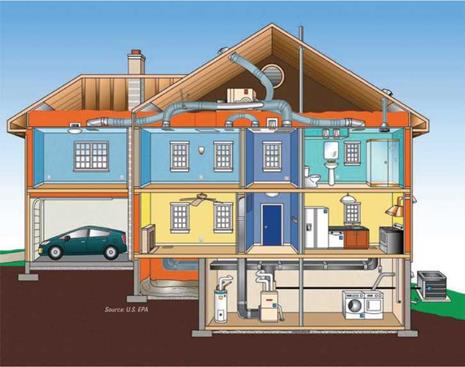The 2012 International Energy Conservation Code, which has been incorporated into the 2012 International Residential Code (IRC) requires whole-house mechanical ventilation to provide adequate fresh air as well as moisture control into the tightly constructed, energy-efficient homes built to the code. With a whole-house mechanical ventilation system, the system operates continuously, providing a constant stream of fresh air to ventilate the home. Advantages to whole-house ventilation also include quiet operation, better moisture control, greater comfort, and less need for motivation to use ventilation fans.
There are different types of whole-house ventilation systems. In some cases, the design of the system needs to be matched to the type of climate—heating or cooling dominated. An effective and popular type of whole-house ventilation system is a balanced mechanical ventilation system. This type of system is available as a Heat Recovery Ventilation (HRV) system or Energy Recovery Ventilation (ERV) system. HRV and ERV systems work similarly and are effective in all types of climates.
In a balanced mechanical ventilation system (see Figure 7.9), fans are used to exhaust air from the home as well as to bring it into the home. Exhaust vents are located in areas of the home where moisture and pollutants are most likely to be generated, including bathrooms. Fresh air vents are centrally located but away from main living areas, such as in an entryway or closet. Exhaust and air pass through a heat exchanger. During the heating season, exhaust air preheats the incoming air. In the cooling season, the exhaust air is cooler than the air, so the reverse process occurs, and the incoming air is cooled. Thus, the house is ventilated and energy is conserved as well.
 |
 |
The HRV system transfers heat between incoming and outgoing air. The ERV system also provides moisture management by dehumidification or humidification, providing further energy savings.



